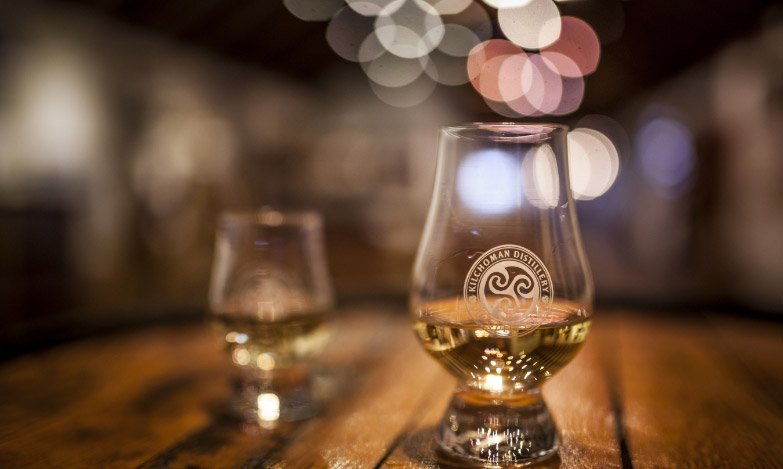BLOG POST
What are the ingredients of a Kilchoman single malt?
October 16, 2018On a Friday evening after a busy week at work, is there anything better than settling down in front of the fire with a large dram of your favourite Kilchoman in hand. As you sit and swirl your dram in the glass have you ever thought what’s happening at the distillery right now, what are they doing there that makes this dram of Kilchoman special and distinct, the reasons are really very simple…………….
Barley
All single malts are created from malted barley. Here at Kilchoman we have two separate barley sources; over 200 tons is grown on the farm at the distillery and distilled exclusively for 100% Islay range, the balance is shipped to Islay from the mainland forming the base ingredient for our core range; Machir Bay, Sanaig as well as most of our limited editions.
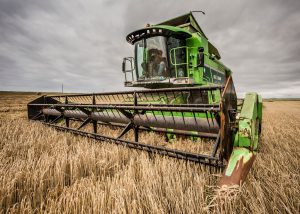
Growing conditions here at Kilchoman are drastically different to that of mainland Scotland. Whilst our soil is excellent quality, the stormy weather and salty atmosphere create a uniquely challenging environment affecting both the characteristics of the barley and the character of our 100% Islay whisky.
It is easy to see why many of Islay’s distillers have turned to mainland grown barely in place of local growers. The low rainfall and settled conditions of the east coast make growing high yielding barley significantly easier. The grains are noticeably larger than those grown on Islay, allowing distilleries to produce 5-10% more whisky per ton compared to Islay barley, like that grown at the distillery.
This year we’ve sown two varieties of barley here at Kilchoman, Concerto and Octavia. The barley made a good start, enjoying long periods of sunny weather broken up nicely by the odd days rain however just as we thought we might have a record harvest the weather turned and a period of wet and windy weather made harvesting a long and challenging process for Andrew and is team. That said the barley is now all safely harvested and we’ll begin to malt the 2018 crop in January.

From left to right – Concerto and Octavia
Water
We draw our water from the Allt Gleann Osamail burn. Fed by a series of springs the water runs off the hills and collects in peat bogs of the Osamail glen just north of the distillery. The peat moss acting as a giant sponge, soaking up the water in winter and drip feeding the burn during drier summer months to ensure we are rarely short of water. The water picks up the distinct dark colour of the peat, resembling black tea. It is soft and pure with particularly low alkaline levels, perfect for distillation.
Peat
Islay Peat is special, and Kilchoman, though the newest distillery on Islay, we are arguably the most traditional in our scale and approach. Growing our own barley is part of this philosophy, however equally important is using Islay peat to smoke our barley. Islay is more exposed to the elements than mainland Scotland. The climate, ocean, wind and rain all have an effect on the island, therefore the peat and the whisky made from Islay peated barley is unlike any other; more salty, maritime and medicinal than mainland peated whiskies.
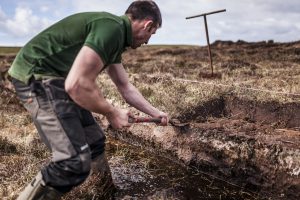
Each week when our green malt has germinated, it is taken to the kiln where it is peated over a 10-hour period. The green malt will lie above the peat fire in the kiln on a perforated floor and peat smoke will gently peculate through the grating imparting that special Islay flavour. Once spread, the door is shut, the fire is lit and we let clouds of smoke build up through the kiln and impart it’s characteristics into our barley. We will use around 80 – 100kg of peat per week and we mix the dried peat, with damp peat that we keep in barrels of water, this avoids our kiln becoming a fire and allows the maltmen to ensure that we are getting as much smoke as possible into the barley. When we light the kiln, we are looking for lots of peat smoke, not flames (as we found out the hard way in 2006!).
Yeast
Yeast is the fourth and final ingredient and it constitutes an essential part of the fermentation process. What exactly does yeast do? Once the mash has been ground down and the barley starch converted into fermentable sugar, the resulting liquid is something called ‘wort’. The wort is then pumped into a washback, and yeast is added. For every mash we create 6,000 liters of wort and we add 20kg of yeast to convert the sugars into alcohol. Every mash at Kilchoman is fermented for an average of almost 90 hours and the resulting alcoholic product is called ‘wash’, at around 8%abv.
There are different kinds of yeast that can be used in the production of single malt scotch: distillers’ yeast, brewer’s yeast, wild yeast, or a combination of each are suitable for scotch. We use Mauri Distillers Yeast during the fermentation process. While it may be more subtle than other elements of production, yeast certainly influences the overall flavour of a scotch whisky as different yeasts breed in different ways, thus influencing its chemical makeup and accentuating certain flavours. Generally speaking, distilleries will use yeasts that can cope with both high temperatures and high amounts of sugar, as well as those which do not clump together during fermentation.
…and the following values
Not only do we have our four main literal ingredients that are needed to make a Kilchoman dram, there are values that we follow, live and work by that have a huge part to play in our final product – Traditional methods in a traditional location, Hard Work, Dedication and Patience
Kilchoman Distillery was the first distillery to open on Islay in over 124 years and is a family run traditional farming distillery. Anthony Wills, our founder, made the decision to open a new distillery on this well-known whisky isle, this was driven by his passion to go back to the grass roots of whisky making. Producing whisky that had been made completing all parts of the process from barley to bottling on site.
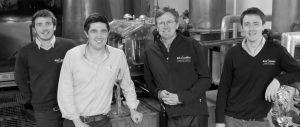 Anthony, with his three sons, (from left to right) Peter, George, Anthony and James.
Anthony, with his three sons, (from left to right) Peter, George, Anthony and James.
It has not always been plain sailing, to produce a Kilchoman single malt takes patience, hard work and more often than not a bit of blood, sweat and tears, however 13 years later Kilchoman still continues to be a traditional family run farming distillery, the farm is thriving, our expansion is underway allowing us to produce more of our unique single malt and the family continue to run the distillery, Kilchoman is going from strength to strength. We hope the values and tradition that Kilchoman stands for offers something different to the whisky world.
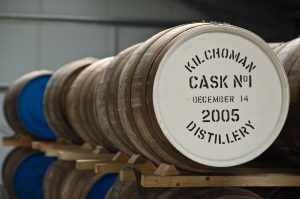
READ NEXT
BLOG POST
Loch Gorm 2025
Loch Gorm 2025 Edition marks a historic first – our first-ever 10 Year Old Loch Gorm. Anthony and Robin have selected 23 Oloroso sherry butts in total: 20 first-fill casks, rich with bold sherry influence, and 3 second-fill casks, adding depth and complexity. Loch Gorm is the name given to…
March 24, 2025

